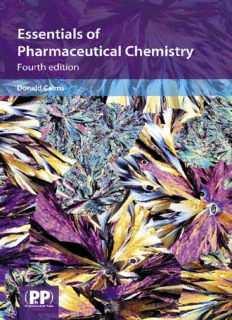
Essentials of Pharmaceutical Chemistry PDF
Preview Essentials of Pharmaceutical Chemistry
Essentials of Pharmaceutical Chemistry Essentials of Pharmaceutical Chemistry FOURTH EDITION Edited by Donald Cairns BSc,PhD,MRPharmS,CSci,CChem,FRSC Acting Head of School of Pharmacy and Life Sciences, The Robert Gordon University, Aberdeen, UK London • Chicago Dedication For Elaine, Andrew and Mairi PublishedbyPharmaceuticalPress 1LambethHighStreet,LondonSE17JN,UK (cid:13)c RoyalPharmaceuticalSocietyofGreatBritain2012 isatrademarkofPharmaceuticalPress PharmaceuticalPressisthepublishingdivisionofthe RoyalPharmaceuticalSociety Firsteditionpublished2000 Secondeditionpublished2003 Thirdeditionpublished2008 Fourtheditionpublished2012 TypesetbyRiverValleyTechnologies,India PrintedinGreatBritainbyTJInternational,Padstow,UK ISBN9780853699798 Allrightsreserved.Nopartofthispublicationmaybereproduced, storedinaretrievalsystem,ortransmittedinanyformorbyanymeans, withoutthepriorwrittenpermissionofthecopyrightholder. Thepublishermakesnorepresentation,expressorimplied, withregardtotheaccuracyoftheinformationcontainedinthisbook andcannotacceptanylegalresponsibilityorliabilityforanyerrorsor omissionsthatmaybemade. TherightofDonaldCairnstobeidentifiedastheauthorofthis workhasbeenassertedbyhiminaccordancewiththeCopyright, DesignsandPatentsAct,1988. AcataloguerecordforthisbookisavailablefromtheBritishLibrary. Contents ix Prefacetothefourthedition x Acknowledgements xi Abouttheauthor 1 Chemistryofacidsandbases 1 Dissociationofweakacidsandbases 3 Hydrolysisofsalts 9 Amphiproticsalts 10 Buffersolutions 11 Buffercapacity 13 Biologicalbuffers 15 Ionisationofdrugs 18 pK valuesofdrugmolecules 19 a pHindicators 19 Tutorialexamples 22 Problems 26 2 Partitioncoefficientandbiopharmacy 29 Experimentalmeasurementofthepartitioncoefficient 32 Drugabsorption,distributionandbioavailability 35 Passivediffusion 38 ThepHpartitionhypothesis 40 Activetransportmechanisms 43 Theactionoflocalanaesthetics 44 Excretionandreabsorptionofdrugs 47 Foodanddrink 48 Tutorialexamples 50 Problems 55 vi Contents 3 Physicochemicalpropertiesofdrugs 57 Carboxylicacids 57 Phenols 61 Warfarin 62 Phenylbutazone 65 Indometacin 65 Barbiturates 65 Phenytoin 67 Sulfonamides 67 Basicdrugs 69 Basicityofheterocycliccompounds 71 Separationofmixtures 71 Tutorialexamples 73 Problems 77 4 Stereochemistry 81 Polarimetry 82 Biologicalsystems 86 Fischerprojections 87 Stereochemistrycasestudy:thalidomide 94 Geometricalisomerism 97 Tutorialexamples 99 Problems 101 5 Drugmetabolism 103 Metabolicpathways 104 CytochromesP450 105 Enzymeinductionandinhibition 109 Drugconjugationreactions(Phase2) 110 Stereochemistry 116 Metabolicpathwaysforcommondrugs 117 Tutorialexample 125 Problems 126 6 Volumetricanalysisofdrugs 129 Volumetricflask 130 Pipette 130 Burettes 131 Unitsofconcentration 131 Workedexample 133 Concentrationofactiveingredients 134 Contents vii Designofanassay 134 Practicalpoints 137 Backandblanktitrations 140 Assayofunit-dosemedicines 143 Non-aqueoustitrations 144 REDOXtitrations 145 Compleximetrictitrations 148 Argentimetrictitrations 149 Limittests 150 Problems 151 7 Analyticalspectroscopy 155 EffectofpHonspectra 159 Instrumentation 163 Experimentalmeasurementofabsorbance 166 Dilutions 167 Quantitativeaspectsofspectroscopy 168 Beer’sandLambert’slaws 168 Methodsofdrugassay 170 Derivativespectroscopy 172 Infraredspectroscopy 174 Fluorimetry 177 Structureelucidation 178 Tutorialexamples 188 Problems 196 8 Chromatographicmethodsofanalysis 199 Definitionsusedinchromatography 199 Typesofchromatography 200 Termsusedinchromatography 211 Tutorialexamples 214 Problems 216 9 Stabilityofdrugsandmedicines 217 Oxidation 217 Hydrolysis 228 Othermechanismsofdegradation 233 Prodrugs 233 Tutorialexamples 235 Problems 237 viii Contents 10 Kineticsofdrugstability 239 Rate,orderandmolecularity 239 Rateequationsandfirst-orderreactions 240 Half-life 243 Shelf-life 243 Second-orderreactions 243 Zero-orderreactions 245 Reactionratesandtemperature 245 Tutorialexample 247 Problems 248 11 LicensingofdrugsandtheBritishPharmacopoeia 249 Europeanlicensingprocedures 250 Applicationsformarketingauthorisations 252 BritishPharmacopoeiaCommission 253 TheBritishPharmacopoeia 254 12 Medicinalchemistry:thescienceofrationaldrugdesign 259 Howdodrugswork? 259 Wheredodrugscomefrom? 266 Whydoweneednewdrugs? 271 13 Answerstoproblems 277 Selectedbibliography 293 Index 295 Preface to the fourth edition In 2007 I wrote in the Preface to the third edition that the science and practice of pharmacy were undergoing a period of change. Now, as I write thePrefacetothefourtheditionofEssentialsofPharmaceuticalChemistry, it seems that the profession is still changing. The General Pharmaceutical Council has replaced the Royal Pharmaceutical Society as the regulator for pharmacy, the number of schools of pharmacy in the UK continues to rise andthereareplanstointegratethecurrentfouryearMPharmdegreeintoa fiveyearintegratedmodelincorporatingtwosixmonthperiodsinpractice. This new edition of EPC (as one of my students calls the book) has been preparedagainstthischangingbackground.Ihavetriedtoincorporatesug- gestions from users and reviewers and have updated every chapter for this edition and included new chapters, Chromatographic methods of analysis andMedicinal Chemistry: the Science of Rational Drug Design. Aswithpreviouseditions,Iamverygratefulforthehelp,advice,comments and encouragement from colleagues, reviewers and the many students of pharmacy and pharmaceutical science who are forced to use this book as part of their studies. I hope they find this new edition useful and, perhaps, experiencesomeofthewonderandenjoymentIfeltwhenIwasintroduced to the chemistry of drugs and medicines more than 30 years ago. If I was being honest with myself, that’s still the way I feel about the subject today. Donald Cairns Aberdeen June 2011
Description: